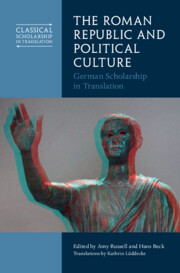1885 results

The Roman Republic and Political Culture
- German Scholarship in Translation
- Coming soon
-
- Expected online publication date:
- September 2024
- Print publication:
- 30 September 2024
-
- Book
- Export citation
Place and Performance in Ancient Greece, Rome, and China
- Coming soon
-
- Expected online publication date:
- August 2024
- Print publication:
- 31 August 2024
-
- Book
- Export citation
HOW DID HOMER'S TROILUS DIE?
-
- Journal:
- The Classical Quarterly , First View
- Published online by Cambridge University Press:
- 03 April 2024, pp. 1-13
-
- Article
-
- You have access
- Open access
- HTML
- Export citation
The Mandate for Speculation: Responding to Uncertainty in Archaeological Thinking
-
- Journal:
- Cambridge Archaeological Journal , First View
- Published online by Cambridge University Press:
- 01 April 2024, pp. 1-16
-
- Article
-
- You have access
- Open access
- HTML
- Export citation
High-Energy Laser Facility PHELIX at GSI: Latest Advances and Extended Capabilities
-
- Journal:
- High Power Laser Science and Engineering / Accepted manuscript
- Published online by Cambridge University Press:
- 01 April 2024, pp. 1-17
-
- Article
-
- You have access
- Open access
- Export citation
Differences by Race and Ethnicity in Title IX’s Effect on Women’s Health
-
- Journal:
- Journal of Benefit-Cost Analysis / Volume 14 / Issue 3 / Winter 2023
- Published online by Cambridge University Press:
- 22 March 2024, pp. 437-450
-
- Article
-
- You have access
- Open access
- HTML
- Export citation
What factors influence individual differences in vulnerability/resilience to sleep loss and/or circadian misalignment? – CORRIGENDUM
-
- Journal:
- Research Directions: Sleep Psychology / Volume 1 / 2024
- Published online by Cambridge University Press:
- 19 February 2024, e8
-
- Article
-
- You have access
- Open access
- HTML
- Export citation
Promoting responsive care and early learning practices in Northern Ghana: results from a counselling intervention within nutrition and health services
-
- Journal:
- Public Health Nutrition / Volume 27 / Issue 1 / 2024
- Published online by Cambridge University Press:
- 08 February 2024, e77
-
- Article
-
- You have access
- Open access
- HTML
- Export citation
Legal assessment of ingrown horns and other horn-related anomalies in cattle and sheep
-
- Journal:
- Animal Welfare / Volume 33 / 2024
- Published online by Cambridge University Press:
- 29 January 2024, e4
-
- Article
-
- You have access
- Open access
- HTML
- Export citation
14C PREPARATION PROTOCOLS FOR ARCHAEOLOGICAL SAMPLES AT THE LMC14, SACLAY, FRANCE
-
- Journal:
- Radiocarbon , First View
- Published online by Cambridge University Press:
- 24 January 2024, pp. 1-14
-
- Article
- Export citation
Discussion: Political Economy of Private Bank Governance in Bangladesh
- from Part II - Six Challenging Institutional Areas
-
-
- Book:
- Is the Bangladesh Paradox Sustainable?
- Published online:
- 10 January 2024
- Print publication:
- 18 January 2024, pp 179-184
-
- Chapter
-
- You have access
- Open access
- HTML
- Export citation
Food provision to support improved nutrition and well-being of people experiencing disadvantage – perspectives of service providers
-
- Journal:
- Public Health Nutrition / Volume 27 / Issue 1 / 2024
- Published online by Cambridge University Press:
- 15 January 2024, e36
-
- Article
-
- You have access
- Open access
- HTML
- Export citation
DEVELOPMENT OF A 14C PROTOCOL AT THE LMC14 FOR THE DATING OF CULTURAL HERITAGE MATERIALS: HISTORICAL MORTARS. PARTICIPATION IN THE MODIS INTERNATIONAL INTERCOMPARISON CAMPAIGN
-
- Journal:
- Radiocarbon , First View
- Published online by Cambridge University Press:
- 11 January 2024, pp. 1-12
-
- Article
- Export citation
24 - Rights of out-of-State residents
- from Part 7 - Federalism
-
- Book:
- Australian Constitutional Law
- Published online:
- 14 December 2023
- Print publication:
- 04 January 2024, pp 695-713
-
- Chapter
- Export citation
6 - External affairs power
- from Part 2 - Legislative powers
-
- Book:
- Australian Constitutional Law
- Published online:
- 14 December 2023
- Print publication:
- 04 January 2024, pp 136-168
-
- Chapter
- Export citation
1 - Introduction to Australian constitutional law
- from Part 1 - Introduction
-
- Book:
- Australian Constitutional Law
- Published online:
- 14 December 2023
- Print publication:
- 04 January 2024, pp 3-38
-
- Chapter
- Export citation
Table of cases
-
- Book:
- Australian Constitutional Law
- Published online:
- 14 December 2023
- Print publication:
- 04 January 2024, pp xviii-xxv
-
- Chapter
- Export citation
Table of statutes
-
- Book:
- Australian Constitutional Law
- Published online:
- 14 December 2023
- Print publication:
- 04 January 2024, pp xxvi-xxx
-
- Chapter
- Export citation
12 - Implied freedom of political communication
- from Part 3 - Limitations on powers
-
- Book:
- Australian Constitutional Law
- Published online:
- 14 December 2023
- Print publication:
- 04 January 2024, pp 322-361
-
- Chapter
- Export citation
8 - Taxation power
- from Part 2 - Legislative powers
-
- Book:
- Australian Constitutional Law
- Published online:
- 14 December 2023
- Print publication:
- 04 January 2024, pp 201-234
-
- Chapter
- Export citation



